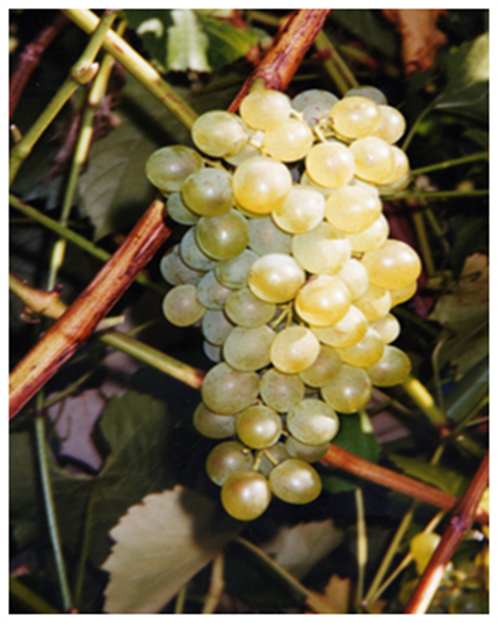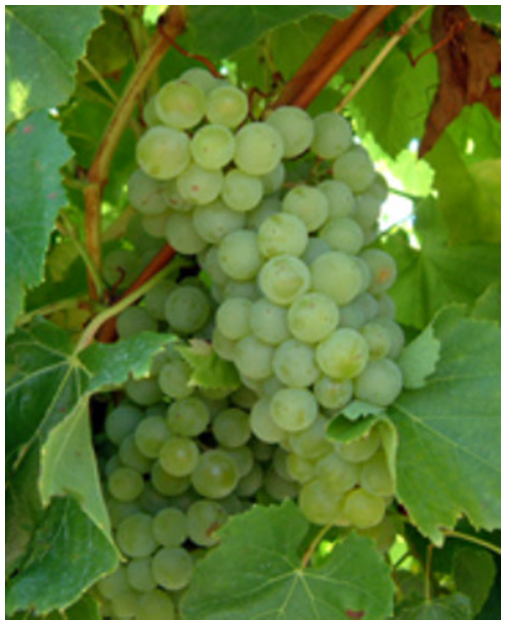Introduction
Pierce’s disease (PD) of grape is caused by the bacterium Xylella fastidiosa (Xf ; Wilcox et al., 2015). Xf is a xylem-limited bacterium. “Xylem-limited” means that Xf only inhabits the xylem elements within the host plant. Xylem elements are the tissues that transport water and nutrients from the roots up to the shoots and leaves. Xf limits water and nutrient translocation by persisting and expanding in the xylem elements and causing the plant to produce tyloses, blocking the “pipes” through which those resources can pass. If the Xf bacterium multiplies and expands enough, the result can be complete obstruction of water and nutrient translocation to aboveground vegetative tissues of the grapevine. Vines will consequently die within one to two years of PD diagnosis, which is well before the anticipated 20- to 25-year productive lifespan of a vineyard in the Eastern U.S. There are many biotic and abiotic pests that make wine grape cultivation challenging in the Southeastern U.S. PD can make it impossible to grow many wine grape cultivars in certain sub regions, as it kills them outright. PD is thus a great threat to the sustainability of commercial vineyards located in warm, coastal, and/or subtropical grape growing regions of the Southeastern U.S. as well as regions in Texas and California.
Range and causal conditions
Xf is endemic to the Southeastern U.S. and is a threat to vine sustainability in sub regions (e.g. Piedmont, Coastal Plain, footshills, etc.) with mildwinters. Pierce’s disease can produce significant losses in vineyards from Florida to Virginia, but also in vineyards westward in Alabama, Texas, and Mississippi. PD is becoming increasingly common in susceptible cultivars (V. vinifera; popular hybrid bunch grapes such as Vidal blanc and Chambourcin) planted in northern Georgia and low-altitude North Carolina and Virginia vineyards. The increasing PD prevalence in the Southeastern U.S. is likely a function of milder winter temperatures (Anas et al., 2008; Lieth et al., 2011). PD is generally less prevalent in vineyards located in northern, high altitude regions on the East Coast (Pennsylvania, New York) as well as inland regions that experience frigid winter temperatures, such as the Midwestern U.S. (Indiana, Michigan, Ohio). Pierce’s disease has been identified, however, in Oklahoma and Missouri (Smith, 2019). It has generally been recommended that producers in Georgia not plant PD-susceptible vines at elevations below 1,300 ft above sea level, and rarely has PD been observed at elevations above 2,000 ft. However, PD has recently been observed to cause significant losses in vineyards at and above 1,300 ft; after warm winters, PD has even been confirmed in vineyards planted above 2,000 ft in northern Georgia, as well as in lower altitude vineyards in the North Carolina foothills. This indicates that the 1,300 ft elevation limit is now at a higher elevation.
Symptoms and identification
As with several systemic grapevine diseases and nutrient imbalances, PD symptoms often become evident around veraison, the growth stage characterized by berry softening, sugar accumulation, and coloration (in red-fruited cultivars). Veraison is also the growth stage at which carbon resource allocation is shifted from the canopy vegetation to the ripening fruit; stressors become visually manifested in the canopy thereafter. Veraison typically occurs in mid- to late- July in many Georgia and Southeastern U.S. vineyards, but this will vary by cultivar, vintage, and growing region. Scouting for PD should begin in mid-July in those regions. Symptoms will occur earlier in drought years, but symptoms are generally most evident from late August through September. In grapevines, Xf causes four visual symptoms that together are strongly associated with PD. Leaf necrosis is observed on the margins of leaves (Figure 1A). Marginal leaf necrosis can be a common response to several vineyard issues; its presence alone should therefore not alarm growers. However, growers are encouraged to contact local Extension agents if the following symptoms are observed in tandem with marginal leaf necrosis. “Matchstick” is the term used to describe the symptom that occurs when only the leaf blade abscises and the petiole (leaf stem) remains attached to the shoot (Figure 1B). “Green islands” describes the phenomenon observed when the shoot tissues harden off unevenly, resulting in green, vegetative “islands” within the brown, woody tissue (Figure 1C). Lastly, as xylem flow is increasingly blocked by bacteria, infected plants will also form “raisins” as the fruit clusters dry out from lack of translocated water (Figure 1D).



 Figure 1. (In order from top to bottom) Pierce’s disease symptoms include marginal leaf necrosis (A), leaf blade abscission from the attached petiole causing “match sticks” (B), “islands” of green tissue on primary grapevine shoots that are normally lignified and brown at this stage (C), and “raisins” (D).
Figure 1. (In order from top to bottom) Pierce’s disease symptoms include marginal leaf necrosis (A), leaf blade abscission from the attached petiole causing “match sticks” (B), “islands” of green tissue on primary grapevine shoots that are normally lignified and brown at this stage (C), and “raisins” (D).
Management
The disease pyramid shows the necessary elements for grapevine PD to occur: a susceptible host, a conducive environment, a vector, an aggressive pathogen, and appropriate timing of vector feeding and bacterial ingress (Figure 2). A subfamily of leafhopper insects called “sharpshooters” are the significant means by which Xf is introduced into grapevines in the Southeastern U.S. Though pruning and root grafting are possible means of infection, these are considered to be of limited importance (Krell et al., 2007). For this reason, without the presence of sharpshooter vectors, grapevine PD is unlikely to occur. The grapevine PD pyramid provides a good basis to develop a PD management plan in vineyards; exclusion or management of any of the five elements shown in the triangle below will result in successful, proactive grapevine PD management.
Annual dormant pruning has been anecdotally shown to aid in PD management in a commercial vineyard in Dahlonega, Georgia; failure to prune can exacerbate premature vine death due to PD. While there is no guarantee that pruning will remove all infected grapevine wood, annual winter pruning of 1-year-old canes can aid in PD management by removing first-year localized Xf infections (Varela et al., 2001). Pruning may particularly aid in managing Xf infections that have occurred relatively later in the growing season, and thus have had a lesser chance of colonizing permanent vine parts before vines enter dormancy, relative to those infections that have occurred earlier in the season (Varela et al., 2001). Indeed, vines infected by Xf earlier in the season (April and May) showed more severe PD symptoms and had less recovery rate relative to vines infected later in the season (June through August)
(Feil et al., 2002). While extremely impractical, cleaning tools with a 10% bleach solution can help reduce mechanical transmission of Xf to uninfected vines, particularly when hedging or trimming canopy shoots during the growing season (Smith, 2019). Once a vine is diagnosed to be PD-positive, the only 100% effective, retroactive management strategy is to rogue and remove the vine from the vineyard. PD symptoms are typically expressed later in the season,and identification may thus coincide with harvest time. If harvest activities preclude the immediate removal of infected vines, it is advised that infected vines be flagged so they can be easily identified for removal after the harvest is complete.
 Figure 2. The five corners of the grapevine Pierce’s disease (PD) pyramid. Xylella fastidiosa, a susceptible grape cultivar, a leafhopper vector, a conducive environment for pathogenicity (like that of the Southeast U.S.), and time and duration of exposure to the vector and pathogen all contribute to and are necessary for PD epidemic development.
Figure 2. The five corners of the grapevine Pierce’s disease (PD) pyramid. Xylella fastidiosa, a susceptible grape cultivar, a leafhopper vector, a conducive environment for pathogenicity (like that of the Southeast U.S.), and time and duration of exposure to the vector and pathogen all contribute to and are necessary for PD epidemic development.
The only way to “manage” a PD-conducive environment is to plant vineyards in northern regions or at elevations where winter temperatures are low enough to prevent the survival of Xf in the plant (Anas et al., 2008; Feil and Purcell, 2001). Population numbers of key insect vectors may also be reduced in colder environments, but this impact of cold winters is likely secondary to reduced bacterial survival. Environments characterized by high and low PD threat can be found within the same state and are generally separated by a vague line of division that moves over time and between vintages. For example, the Texas Hill Country and north Georgia mountains are planted with PD-susceptible hybrid and vinifera cultivars, while the Texas Gulf Coast and Georgia Piedmont are planted with PD-tolerant cultivars.
Planting grapevine cultivars known to be tolerant to Xf is the best way to proactively manage PD in environments that are conducive to sustained Xf exposure. Tolerant cultivars are generally void of symptoms and their productivity is unaffected when planted in PD-conducive environments. Most muscadine cultivars and several hybrid wine grape cultivars (e.g. ‘Blanc du Bois’ in Figure 3A, ‘Villard blanc’ in Figure 3B, ‘Lenoir’ in Figure 3C, ‘Norton’, etc.) tolerate Xf and therefore do not often show PD symptoms. While ‘Villard blanc’ is generally accepted as “PD-tolerant,” growers have reported visual PD symptoms in Villard blanc vineyards in the Southeastern U.S., and the same is true of Norton if grown under heavy PD pressure. Several T.V. Munson cultivars are also PD-tolerant (Kamas et al. 2010), the most popular of those being ‘Lomanto’ (Figure 3D).
‘Crimson Cabernet’, a privately bred, publicly available, red-berried cultivar developed from crosses between ‘Norton’ and ‘Cabernet Sauvignon’, has anecdotal PD-tolerance. However, some vines of 'Crimson Cabernet' planted in the Georgia Piedmont have shown some symptoms and tested positive for Xf within 10 years of planting, indicating that this cultivar may not be suitable in very high-PD risk environments.
High V. vinifera-parentage selections from Professor Andy Walker’s breeding program at University of California–Davis tolerate PD and produce vinifera-like quality wines. Two white and three red selections with 94% (‘Camminare Noir’) or 97% (‘Ambulo Blanc’, ‘Caminante Blanc’, ‘Errante Noir’, and ‘Paseante Noir’) vinifera genetics have been commercially released. Field trials are currently underway in Georgia and elsewhere in the Southeast to evaluate the growth and performance of ‘Crimson Cabernet’ and UC Davis selections.



 Figure 3. Popular wine grape cultivars that are generally proven to be PD-tolerant and produce acceptable consumer wine quality, including (A–D, in the order they appear) ‘Blanc du Bois’ (A), ‘Villard blanc’ (B), ‘Lenoir’ (C), and ‘Lomanto’ (D). ‘Blanc du Bois’ and ‘Villard blanc’ photos courtesy of Fritz Westover; ‘Lomanto’ and ‘Lenoir’ photos courtesy of Joey Muller.
Figure 3. Popular wine grape cultivars that are generally proven to be PD-tolerant and produce acceptable consumer wine quality, including (A–D, in the order they appear) ‘Blanc du Bois’ (A), ‘Villard blanc’ (B), ‘Lenoir’ (C), and ‘Lomanto’ (D). ‘Blanc du Bois’ and ‘Villard blanc’ photos courtesy of Fritz Westover; ‘Lomanto’ and ‘Lenoir’ photos courtesy of Joey Muller.
The PD-causing Xf is vectored and transmitted by xylem-feeding sharpshooters (Cicadellidae: Cicadellinae) and spittlebugs (Cercopidae) which feed on green, vegetative shoots of the grapevine. Many xylem-feeding leafhoppers, such as the broad- headed sharpshooter (Oncometopia orbona), versute sharpshooter (Graphocephala versuta), and the red- banded leafhopper (Graphocephala coccinea), are found in the Southeaste